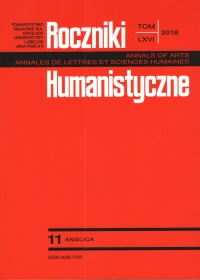In Search of a New Ontological Category in Language: Event Sub-Kinds
Abstract
Our analyses of reflexive impersonals with dative logical subjects and of dispositional middles proper in Polish result in the hypothesis that the inventory of event categories represented in linguistic theory should be broadened to include event sub-kinds, alongside event kinds and event tokens. The morpho-syntax and syntax of clauses containing the two types of structures mentioned above seem to suggest that one more ontological category is needed to account for the distribution of manner modifiers vs. spatio-temporal modifiers, logical subjects (or agentive participants) in the non-canonical case forms, as well as to explain the distribution of agent-oriented adverbs in the relevant sentences in Polish. Reflexive impersonal clauses with dative logical subjects and the ones containing dispositional middles proper differ significantly from the clauses addressing event kinds and event tokens. Consequently, they require a different treatment in linguistic theory.
References
Ackema, Peter, and Maaike Schoorlemmer. 1995. “Middles and non-movement.” Linguistic Inquiry 26: 173-197. https//doi.org/10.1075/sal.2.08oua.
Ackema, Peter, and Maaike Schoorlemmer. 2006. “Middles.” In Martin Everaert and Henk van Riemsdijk (eds.). The Blackwell companion to syntax. Vol III, 131–203. Oxford: Basil Blackwell.
Carlson, Gregory, and Francis Jeffry Pelletier (eds). 1995. The generic book. Chicago: University of Chicago Press.
Carlson, Gregory. 1977. Reference to kinds in English. New York, London: Garland Publishing.
Chachulska, Beata, and Rafał Górski. 2002. “Frekwencja form wyrażających kategorię bierności [Frequency of the forms expressing the category of passivity].” Język Polski 82: 252–259.
Chierchia, Gennary, and Sally McConnell-Ginet. 2000. Meaning and grammar: An introduction to semantics. 2nd ed. Cambridge, MA: MIT Press.
Cichosz, Natalia. (2014). “Polish Experiencer and Affectedness Datives as Adjuncts.” Proceedings of ConSOLE 22: 39–57.
Comrie, Bernard. 1976. Aspect. Cambridge: Cambridge University Press.
Condoravdi, Cleo. 1989. “The middle: Where semantics and morphology meet.” MIT Working Papers in Linguistics 11: 18-30.
Fagan, Sarah. 1988. “The English middle.” Linguistic Inquiry 19, 181-203. https://doi.org/10.1017/S0022226700015772.
Farkas, Donka, and Yoko Sugioka. 1983. “Restrictive if/when clauses.” Linguistics and Philosophy 6: 225–258.
Filip, Hana. 1999. Aspect, eventuality types and nominal reference. New York: Garland Publishing.
Filip, Hana. 2008. “Events and maximalization: The case of telicity and perfectivity.” In Susan Rothstein (ed.). Theoretical and crosslinguistic approaches to the semantics of aspect, 217–253. Amsterdam: John Benjamins Publishing Company.
Filip, Hana. 2013. “Slavic aspect: A constantly moving goal.” Paper presented at Leipzig Universität, Leipzig, Germany, December 5.
Fisiak, Jacek, Maria Lipińska-Grzegorek, and Tadeusz Zabrocki. 1978. An introductory Polish-English contrastive grammar. Warszawa: Państwowe Wydawnictwo Naukowe.
Fried, Mirjam. 2006. “Agent-backgrounding as a functional domain: Reflexivization and passivization in Czech and Russian.” In Benjamin Lyngfelt and Torgrim Solstad (eds.). Demoting the agent: Passive, middle, and other voice phenomena, 83-110. Amsterdam: John Benjamins Publishing Company.
Gehrke, Berit. 2011. “Stative passives and event kinds.” In Ingo Reich, Eva Horch, and Dennis Pauly. Sinn und Bedeutung 15. Proceedings of the 2010 Annual Conference of the Gesellschaft für Semantik, 241–257. Saarbrücken: Saarland University Press.
Gehrke, Berit. 2015. “Adjectival participles, event kind modification and pseudo-incorporation.” Natural Language and Linguistic Theory 33, 897–938. https//doi.org/10.1007/s11049-015-9295-7.
Gehrke, Berit, and Louise McNally. 2011. “Frequency adjectives and assertions about event types.” SALT Proceedings 19: 180–197. http://dx.doi.org/10.3765/salt.v19i0.2523.
Heim, Irene. 1982. The semantics of definite and indefinite noun phrases. Ph.D. dissertation. University of Massachusetts.
Holvoet, Axel, and Jadwiga Linde-Usiekniewicz. 2016. “The middle voice in Polish: An attempt at rehabilitation.” Studies in Polish Linguistics 10, 105-124. http://dx.doi.org/10.4467/23005920SPL.15.005.4313.
Keenan, Edward L. 1976. “Towards a universal definition of subject.” In Charles N. Li (ed.), Subject and topic, 303–334. New York, NY: Academic Press.
Keyser, Samuel Jay, and Thomas Roeper. 1984. “On the middle and ergative constructions in English.” Linguistic Inquiry 15: 381–416.
Krifka, Manfred, Francis Jeffry Pelletier, Gregory Carlson, Alice ter Meulen, Gennaro Chierchia, and Godehard. 1995. “Genericity: An introduction.” In Gregory Carlson and Francis Jeffry Pelletier (eds.). The generic book, 1–124. Chicago: Chicago University Press.
Krzek, Małgorzata. 2010. “Some aspects of subjects of impersonal constructions in Polish.” Newcastle Working Papers in Linguistics 16, 66–87.
Laskowski, Roman. 1984. “Kategorie morfologiczne języka polskiego—charakterystyka funkcjonalna. [Morphological categories of the Polish language—a functional characteristic].” In Renata Grzegorczykowa, Roman Laskowski, and Henryk Wróbel (eds.), Morfologia [Morphology], 121–163. Warszawa: Państwowe Wydawnictwo Naukowe.
Lekakou, Marika. (2006). “A comparative view of the requirement for adverbial modification in middles.” In Benjamin Lyngfelt and Torgrim Solstad (eds.). Demoting the agent: Passive, middle, and other voice phenomena, 223–247. Chicago: Chicago Linguistic Society.
Malchukov, Andrej, and Akio Ogawa. 2011. “Towards a typology of impersonal constructions.” In Andrej Malchukov and Anna Siewierska (eds.). Impersonal constructions. A cross-linguistic perspective, 19–56. Amsterdam, Philadelphia: John Benjamins Publishing Company.
Malchukov, Andrej, and Anna Siewierska. 2011. “Introduction.” In Andrej Malchukov and Anna Siewierska (eds.). Impersonal constructions. A cross-linguistic perspective, 1-18. Amsterdam, Philadelphia: John Benjamins Publishing Company.
Malicka-Kleparska, Anna. 2017. Middles in English and Polish. Lublin: Wydawnictwo KUL.
McConnell-Ginet, Sally. 1994. “On the non-optimality of certain modifiers.” SALT Proceedings 4: 230–250.
Milsark, Gary. 1977. “Toward an explanation of certain peculiarities of the existential construction in English.” Linguistic Analysis 3: 1-29.
Nagórko, Alicja. 1997/2008. Zarys gramatyki polskiej [Rudiments of Polish grammar]. Warszawa: Państwowe Wydawnictwo Naukowe.
Przepiórkowski, Adam, Mirosław Bańko, Rafał Górski, and Barbara Lewandowska-Tomaszczyk (eds.). 2012. Narodowy Korpus Języka Polskiego. Warszawa: Wydawnictwo Naukowe PWN.
Rivero, María Luisa, Ana Arregui, and Ewelina Frąckowiak. 2010. “Variation in circumstantial modality: Polish versus St’át’imcets.” Linguistic Inquiry 41: 704-714.
Rivero, María Luisa, and Ana Arregui. 2012. “Building involuntary states in Slavic.” In Violeta Demonte, and Louise McNally (eds.). Telicity, change and state. A cross-categorial view of event structure, 300-332. Oxford: Oxford University Press.
Smith, Carlota. 1997. The parameter of aspect. Dordrecht: Kluwer.
Tabakowska, Elżbieta. 2003. “Those notorious Polish reflexive pronouns: a plea for middle voice.” Glossos, 1-18.
Wierzbicka, Anna. 1967. “On the semantics of verbal aspect in Polish.” In To Honor Roman Jakobson. Vol. 3, 2231–2249. The Hague: Mouton.
Willim, Ewa. 2006. Event, individuation and countability. Study with special reference to English and Polish. Kraków: Jagiellonian University Press.
Copyright (c) 2018 Roczniki Humanistyczne

This work is licensed under a Creative Commons Attribution-NonCommercial-NoDerivatives 4.0 International License.





